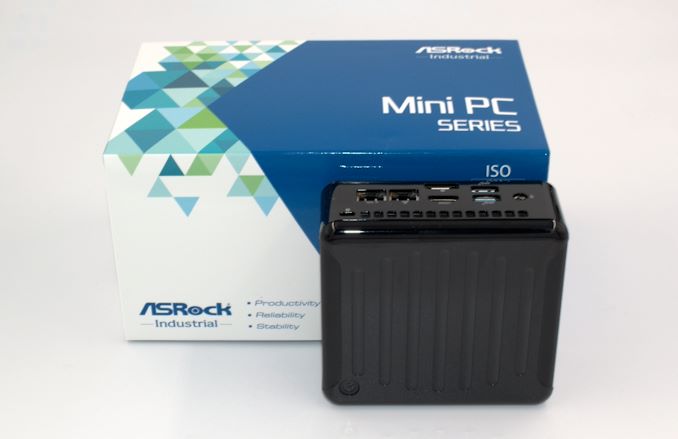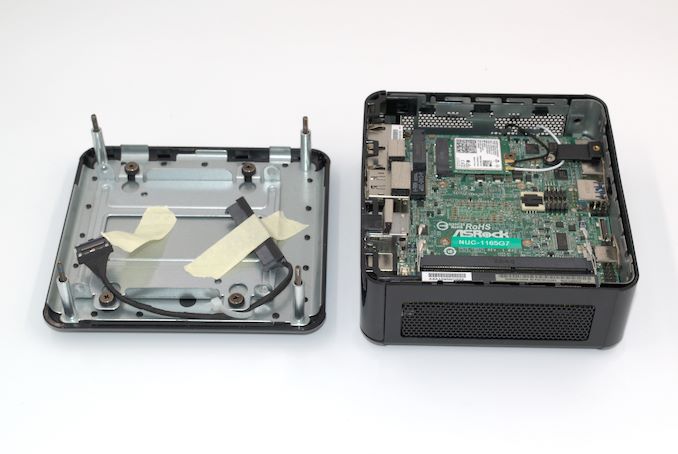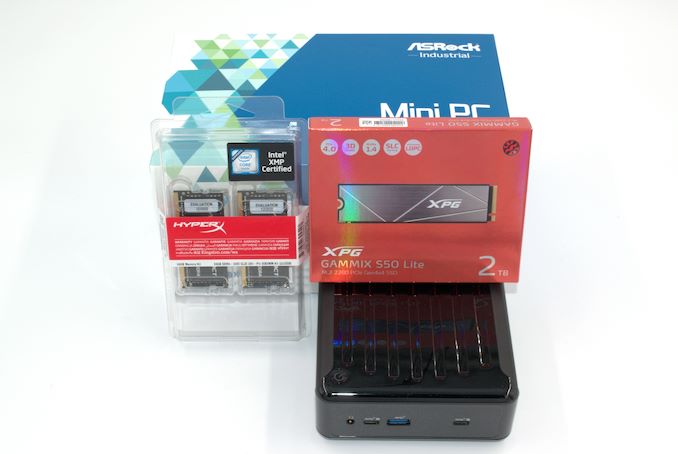ASRock Industrial NUC BOX-1165G7 Mini-PC Review: An Ultra-Compact Tiger Lake Desktop
by Ganesh T S on August 26, 2021 8:15 AM EST- Posted in
- Systems
- Intel
- NUC
- UCFF
- Willow Cove
- ASRock Industrial
- Tiger Lake-U

Intel introduced the Willow Cove micro-architecture with their Tiger Lake processors in the second half of 2020. These were designed to span a wide range of performance levels and applications, with TDPs ranging from as low as 7W up to 65W.
While mobile systems are the prime market for the 7W - 15W SKUs, higher TDP processors have found themselves in a number of different form-factors ranging from notebooks and UCFF mini-PCs to full-blown gaming desktops. Many ultra-compact mini-PCs based on Tiger Lake have been introduced by different vendors in the last few quarters, but challenges in the global semiconductor supply chain have resulted in scarce supply. ASRock Industrial was one of the first to announce a 'NUC' based on Tiger Lake - the 1100 BOX series. Introduced in October 2020, it started appearing in the channel in early 2021.
We have already seen the capabilities of Tiger Lake in a gaming desktop (Beast Canyon NUC). In that system, Tiger Lake appeared in a 8C/16T 65W TDP avatar. Developments related to ultra-compact form-factor (UCFF) machines over the last decade have resulted in systems that are able to successfully handle 28W TDP processors, and that has become the de-facto standard for high-performance UCFF PCs. ASRock Industrial's NUC 1100 BOX series has three SKUs, all of which are based on 28W TDP Tiger Lake-U processors. The flagship SKU is the NUC BOX-1165G7 based on the Intel Core i7-1165G7.
Competitively speaking, the Tiger Lake UCFF PCs come in at a time when systems based on AMD's compelling 7nm Zen 2-based Ryzen 4000U series of processors are already well-established in the market. Advancements in power efficiency and performance per watt, along with a slew of platform updates had enabled Zen 2-based mini-PCs to present a credible challenge to Comet Lake-based systems in terms of value proposition. Can Tiger Lake shift the metric back towards Intel? This review takes a look at the features and capabilities of the NUC BOX-1165G7, with some commentary on what Tiger Lake brings to the table for machines in this form-factor.
Introduction and Product Impressions
ASRock is a well-known vendor in the consumer PC market. In 2011, the company set up the ASRock Industrial business unit to focus on industrial motherboards. The division branched out in 2018 as an independent vendor with exclusive focus on B2B products. The company has products for deployment in small businesses (offices), automation, robotics, security, and other industrial / IoT applications.
Primarily, the company develops motherboards, and sells them to various system integrators who can do their own value additions. For example, OnLogic's ML100G-40 is based on ASRock Industrial's 4X4-V1000M AMD Ryzen Embedded motherboard. As we saw in our review of the ASRock Industrial 4X4 BOX-V1000M and the 4X4 BOX-4800U, the company also sells mini-PCs based on the developed motherboards into the retail channel. The motherboard enclosure bears a strong resemblance to ASRock's Beebox series. ASRock has not updated the Beebox since the introduction of Kaby Lake, possibly not wanting to step into ASRock Industrial's BOX series of UCFF PCs.
ASRock Industrial has two distinct actively-cooled UCFF PC lineups - the NUC BOX series based on Intel's processors, and the 4X4 BOX series based on AMD Ryzen. Using processors configured with TDPs up to 28W, these clones of the Intel's mainstream NUCs service a wide range of applications. The NUC 1100 series of Tiger Lake-U motherboards comes in three different versions, as we outlined in our coverage of the introduction of the lineup last year.
The NUC-1165G7 places the 4.09" x 4.02" (103.9 mm x 102.1 mm) motherboard inside a chassis measuring 110 mm x 117.5 mm x 47.85 mm. The height allows ASRock Industrial to integrate support for a 2.5" SATA drive, should the end user require installation of one. With its B2B focus, and need for the system to service embedded and industrial applications, the company also integrates a watchdog timer and hardware TPM (from Infineon) on the motherboard. The soldered processor (Intel Core i7-1165G7) has four cores with hyperthreading enabled. It can operate with a TDP configurable between 12W and 28W, with ASRock Industrial setting it to 28W in the NUC BOX-1165G7.
Our review sample was barebones, similar to the system currently being sold in the channel. We configured it with 64GB of Kingston's HyperX Impact DD4 SODIMMs (now, Kingston Fury) and ADATA's entry-level low-power PCIe 4.0 SSD - the XPG GAMMIX S50 Lite.
The specifications of our ASRock Industrial NUC BOX-1165G7 review configuration are summarized in the table below.
| ASRock NUC BOX-1165G7 Specifications | |
| Processor | Intel Core i7-1165G7 Tiger Lake-U 4C/8T, 2.8 - 4.7 GHz Intel 10nm, 12 MB L2, 12 - 28 W (28W) --- |
| Memory | Kingston HyperX Impact KHX3200C20S4/32GX DDR4-3200 SODIMM 20-22-22-48 @ 3200 MHz 2x32 GB |
| Graphics | Intel Iris Xe Graphics (96EU) |
| Disk Drive(s) | ADATA XPG GAMMIX S50 Lite (2 TB; M.2 Type 2280 PCIe 4.0 x4 NVMe; Micron 96L 3D TLC) (Silicon Motion SM2267 Controller) |
| Networking | Intel Wi-Fi 6 AX200 1 × GbE port (Intel I219-V) 1 × 2.5 GbE port (Intel I225-LM) |
| Audio | 3.5mm Headphone Jack (Realtek ALC233) Capable of 5.1/7.1 digital output with HD audio bitstreaming (HDMI / DP) |
| Miscellaneous I/O Ports | 2x USB 3.2 Gen 2 Type-A (rear) 1x USB 3.2 Gen 2 Type-A (front) 1x Thunderbolt 4 Type-C (front) 1x USB 3.2 Gen 2 Type-C (front) |
| Operating System | Retail unit is barebones, but we installed Windows 10 Enterprise x64 |
| Pricing | $583 (barebones) $1073 (as configured / No OS) |
| Full Specifications | NUC BOX-1165G7 Specifications |
The ASRock NUC BOX-1165G7 kit doesn't come with any pre-installed OS. Necessary drivers can be downloaded off ASRock Industrial's product support page. In addition to the main unit, the other components of the package include a 90 W (19V @ 4.7A) adapter, a US power cord, a VESA mount (along with the necessary screws), two M.2 screws, and a quick-start guide.
The various chassis features and internal motherboard layout can be gleaned from the two galleries below.






















33 Comments
View All Comments
dullard - Friday, August 27, 2021 - link
1) "Asrock Industrial" is the name of the company.2) The thing that most defines industrial computers is the promise to keep parts and productions for longer than most other computers. If you buy a Dell home computer, it might have a randomly selected hard drive or memory that differs each time you order it. If you buy a Dell business computer, you might get the same hard drive or same memory for a couple years. Many industrial computers have the exact same parts guaranteed to be in production for often up to 7 years. That really matters when you put in a fortune into equipment and another fortune into qualification of that equipment and suddenly the computer goes down.
Fanless is nice, but certainly not the biggest industrial need.
zsdersw - Monday, August 30, 2021 - link
If it's not fanless and rugged it's not "industrial", as its components won't last as long (dust and other particulates in the air are never good for electronics). Using a computer in an industrial environment commands a level of ruggedness that you won't find in any computer fan.dullard - Monday, August 30, 2021 - link
There are plenty of industries that are not filthy.mode_13h - Tuesday, August 31, 2021 - link
Yeah, exactly. There are applications like kiosks, point-of-sale, and backroom appliances.zsdersw - Tuesday, August 31, 2021 - link
All of which benefit from fanless computers. Dust is everywhere and always bad for electronics.dullard - Tuesday, August 31, 2021 - link
Dust can also collect on fins on fanless computers and render their cooling worse. It isn't a concept of "works" vs "doesn't work".zsdersw - Wednesday, September 1, 2021 - link
It can, but with nothing to draw dust inside the computer it doesn't happen to a noticeable degree over the time between when the computer is deployed and when it's obsolete.mode_13h - Tuesday, September 21, 2021 - link
> with nothing to draw dust inside the computer it doesn't happen to a noticeable degree> over the time between when the computer is deployed and when it's obsolete.
That's not necessarily true. It depends on how prone the enclosure is to collecting dust, the orientation in which it's mounted, how much dust is in the environment where it's used, and how long it remains in service. It's not uncommon for machines to have a service life of close to a decade.
Yes, we can agree that fanless is the better option, if you're at all worried about dust. Whoever wants this SFF "industrial" PC must care more about size and performance than maintenance costs.
Manvadher - Friday, August 27, 2021 - link
I really love this site and its reviews but why did you do this"The NUC-1165G7 places the 4.09" x 4.02" motherboard inside a chassis measuring 110 mm x 117.5 mm x 47.85 mm"
Two different units in the same sentence!
Either way thank you for the review!
ganeshts - Monday, August 30, 2021 - link
The 4x4 and 5x5 are recognized stand-ins for the NUC and mini-STX form-factors respectively, and I was using the imperial measurements to convey that this is a standard NUC board. I have since edited the piece to add the SI measurements also for the motherboard dimensions.